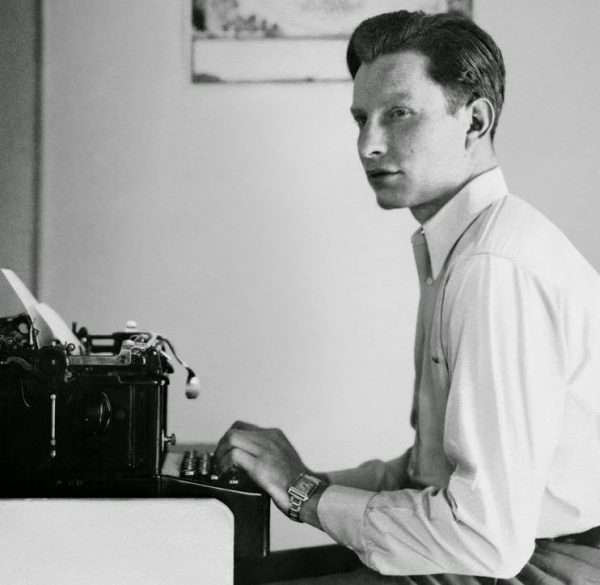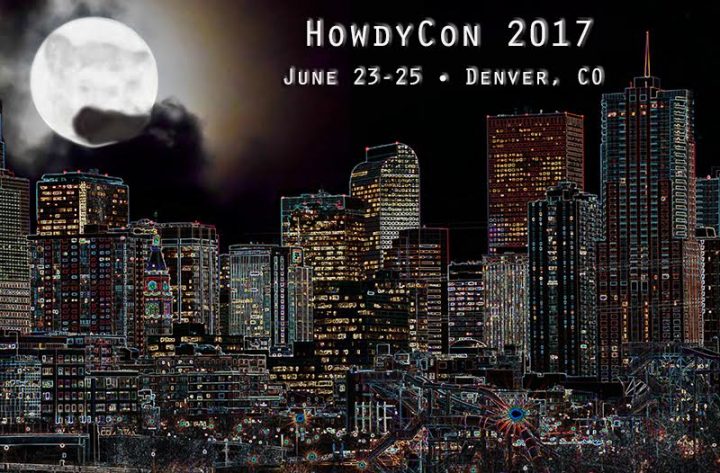On Saturday, Scientology leader David Miscavige blessed the newest “Ideal Org” with another grand opening ceremony, this time in San Diego, California. After the ceremony we heard from local journalist Ken Stone, who told us he found it very odd that Scientology had held an event with what they claimed was a crowd of 3,500, and had done so without notifying the local press.
Ken decided to look into things a little further and managed to get an interview with Scientology’s public relations B-team, Erin and Nick Banks. The result was a nice piece by Ken that included the usual howlers from Erin about how the new org was a gleaming example of Scientology expansion — even though it was really just a renovation of the building they’d been in for years and years and didn’t represent any “expansion” at all. (And as for the size of the crowd, we’ve found that if you divide by about seven, you get closer to actual truth, which suggests that the event probably had closer to 800 people in attendance, many of whom would have been bused down from Los Angeles.)
Ken attached to his story the press release Scientology put out about Miscavige’s appearance, and several people pointed out to us that it included this rather astounding claim…
“Even after forty years LRH would fondly recall this ‘never-never land,’ where he spun his first tales for the pulps, in a cottage on the bluff,” said Mr. Miscavige. “This was also his first point of departure for Asia — boarding a naval transport with a well-worn suit, a thin topcoat and two pennies. While in the wake of Waikiki, he tells of importing a board from Honolulu, and so became the first to catch a wave at Encinitas. So, yes, this is the crossroads of your history with LRH — and your future with his legacy.”
This really surprised us because in recent years Scientology has finally started to tamp down some of its more outrageous mythmaking about Hubbard after being caught time after time making up stuff about the man. (Which, to be fair, Hubbard himself had started.)
Miscavige’s claim sent us digging into Russell Miller’s excellent 1987 biography of Hubbard, Bare-Faced Messiah, to check up on what the church leader might be referring to.
Hubbard made a couple of trips to Asia as a youth. The first was a 1927 voyage that left and returned from Washington state. His second voyage, to Guam and China in 1928, did leave from San Diego, but he quickly headed back to Montana after the return leg of his voyage and wouldn’t have spent much time in San Diego, if at all. But as for Miscavige’s statement, that San Diego was Hubbard’s “first point of departure for Asia” — it’s somewhat true, if he meant that it was Hubbard’s “first point of departure on his second trip to Asia.”
Anyway, it’s the next claim that really got our attention. Several years after his two trips to Asia, both of which would have included stops in Hawaii (thus “in the wake of Waikiki” in the tortured syntax of Miscavige speechwriter Dan Sherman), Hubbard returned to the San Diego area in 1934.
He was 23 years old and had with him his pregnant first wife, Polly Grubb, and his situation was rather dicey. The Great Depression was at its depths, and Hubbard had mouths to feed and not very good prospects. He had tried to be a writer, but it was difficult to make a living at it. Miller tells us that out of desperation, Hubbard tried his hand at the pulps, writing adventure stories.
In 1934, more than 150 pulp magazines were published in New York alone. Black Mask was considered the best of the bunch by writers, largely because it paid its top contributors as much as a nickel a word, but Argosy, Adventure, Dime Detective and Dime Western were all said to offer more than the basic rate of a cent a word to the best writers. As the average 128-page pulp magazine contained around 65,000 words and as many of them were published weekly, the market for freelance writers was both enormous and potentially lucrative. Of all this L. Ron Hubbard knew virtually nothing until he began to cast around for new outlets as a matter of urgency after his first disastrous year as a writer. ‘He told me’, said his Aunt Marnie, ‘that he went into a bookstall and picked up all the pulp books from the rack. He took a big pile home to see what it was that people wanted to read. He thought a lot of it was junk and he knew he could do better. That’s how he started writing mystery stories.’
Soon enough, Ron was having success placing stories that he churned out at a prodigious rate, and his income began to rise.
By the end of April Ron had earned enough money to take Polly on a short holiday to California. They took a cheap hotel room at Encinitas, a resort a few miles north of San Diego, but Polly, now seven months into her pregnancy, found the unaccustomed heat somewhat debilitating. On 7 May 1934, she decided to take a dip in the ocean to cool off and got caught in a rip tide. She was a strong swimmer but only just managed to get back to the beach and the exertion brought on labor. Later that day she gave birth to a son. The baby weighed only 2lb 2oz and clung to life by the most gossamer of threads. Praying he would survive, they named him Lafayette Ronald Hubbard Junior.
Now see, that’s a great story. But because Miscavige and the Church of Scientology are in the habit of pretending that Hubbard didn’t have seven children by three different wives (and that one of his marriages was bigamous), Miscavige can’t tell his audience the charming story of how the California surf was responsible for L. Ron Hubbard Jr.’s premature birth.
Instead, he says that Hubbard had a surfboard imported from Hawaii and that he became, in 1934, the first person in history to surf a wave in Encinitas.
Well, it didn’t take long to debunk this Hubbard myth. A website specifically aimed at surfing in North San Diego County suggests that anyone surfing in 1934 was ridiculously late to claim to be a pioneer.
George Freeth introduced surfing to the California coastline in 1907 and he died in San Diego during the flu epidemic of 1919. He may have surfed in the Encinitas area, but it is likely that we will never know. There may not have been many active surfers in those early days in Encinitas and Cardiff, but they did exist.
Just up the coast, Duke Kahanamoku began popularizing surfing in the Los Angeles area in 1912. Another website, maintained by the University of California, points out that there was already competitive surfing happening in the San Diego area by 1928, six years before Ron supposedly “imported” his surfboard while living hand to mouth as a pulp writer in an Encinitas cottage.
Is it possible that Hubbard, if he actually did paddle out for a session in 1934, was unaware that California’s surf pioneer George Freeth had not only preceded him by decades, but had already been dead for 15 years, and so the pulp fiction writer simply assumed he was the first man to carve up a wave on that stretch of beach? Sure, it’s possible. But that doesn’t explain Miscavige making the claim that Hubbard was first when it’s so easy to check that he was not.
But such is the precarious state of any information put out by the Church of Scientology.
After his interview with Nick and Erin Banks, Ken Stone shared with us what they had said. We told Ken we wish we’d known it was the Banks JV squad that he’d be talking to. (Erin and Nick are sent out to Ideal Org openings and other situations where a Scientology spokesperson is needed for handling the local press. Scientology’s top mouthpiece, Los Angeles-based international spokeswoman Karin Pouw, is never seen by reporters.)
To explain what we meant, allow us a quick digression. Last year, we published The Unbreakable Miss Lovely, a book about the horrendous (and legendary) abuse that Scientology put Paulette Cooper through from 1969 to 1985. She was one of the first journalists to expose Hubbard and Scientology, and she nearly paid for it with her life. One of the things the church’s spy wing, the Guardian’s Office (today known as the Office of Special Affairs), did was to have spies befriend Paulette and move into her apartment building to be close to her. One of them was a woman named Paula Tyler, who spent months pretending to be one of Paulette’s best friends in 1973, the year Paulette had been framed by Scientology for a crime she didn’t commit and was facing 15 years in federal prison. Paula Tyler visited Paulette almost every day, and reported back to the church what she was saying as Paulette awaited trial. Eventually, Paulette managed to get out of the prosecution, but a legal cloud still hung over her until 1977, when the FBI raided the church and documents were found that spelled out the scheme to frame her. The FBI then contacted Paulette to get her help with a case they were building against the members of the Guardian’s Office.
Here’s what happened next, from the book…
Finally, after eight years of harassment, an indictment, the lawsuits, the expense, the harm to her career – finally, she was going to be publicly exonerated. When, she didn’t know. But now that the FBI was on her side, things were going to be very different…
Even as agents began coming over to her apartment at the Churchill to talk to her about Scientology, they were careful not to show her the Operation Freakout documents or anything else referring to her. It was disappointing, and she had no idea how long she’d have to wait before she could see what they had found. But they did show her photographs. And what they showed her stunned her.
One showed Paula Tyler. She was the young woman from California Paulette had helped get an apartment in her building. The young woman who had been introduced to Paulette by Margie Shepherd after Margie had showed up at her door canvassing for Cesar Chavez. The woman who, after moving into the Churchill, had come over constantly to talk with Paulette about her troubles. The woman who had introduced her to Jerry Levin
The woman who suddenly had to go to Europe after Paulette had spotted a photograph of someone who looked like her in a Scientology magazine.
That Paula Tyler.
The FBI showed Paulette photographs they had taken of Scientologists in their investigations, and she spotted Paula. She told them about her. And about Margie Shepherd. And about Jerry Levin. All of them, she now began to realize, were working for Scientology.
She thought of her teenage diary, tucked way back in her coat closet. It was Jerry, she suspected, who had taken it out and copied pages of it for the church so they could be dropped off at her father’s office three years ago. It was Jerry who always wanted her to come up to the roof. To look at the view from the ledge, where she always felt nervous.
It was Paula and Jerry she had confided in, telling them her fears as she was at her absolute lowest, while awaiting trial in 1973. And everything she had told them, she knew, had gone right to Scientology.
She wanted to throw up.
And then, much later in the book…
The other person who infiltrated Paulette’s life, Paula Tyler, is less of a mystery. She’s still a church member, and lives in Clearwater, Florida. She didn’t respond to questions about her role in the operation against Paulette. Like other former GO operatives, Tyler has remained a church member but hasn’t played a visible role in the church’s management.
Her daughter is a different story. Erin Banks rose through Scientology’s public relations ranks, and by 2013 had made it to the national media office. Her comments to newspapers show up when a new building opens in the Midwest, for example. On Scientology’s web page describing its PR team, she’s listed on the second rank along with her husband, Nick Banks.
It would have been interesting to tip off Ken about Erin and Nick to see what she might say about her connection to Scientology’s legendary spy operations. However, he did ask her about the criticism that Scientology eternally suffers, that’s it’s really a mind-control cult.
“I don’t hear that at all,” she responded. “That’s something we used to run across, say, in the ’70s.”
Well, the truth is Scientology has never suffered from worse press than it has in the last decade. But still, Erin did have a point. Scientology did get a certain reputation in the 1970s.
And she ought to know all about it.
——————–
Go here to start making your plans.
——————–
 Posted by Tony Ortega on November 25, 2016 at 07:00
Posted by Tony Ortega on November 25, 2016 at 07:00
E-mail tips and story ideas to tonyo94 AT gmail DOT com or follow us on Twitter. We post behind-the-scenes updates at our Facebook author page. After every new story we send out an alert to our e-mail list and our FB page.
Our book, The Unbreakable Miss Lovely: How the Church of Scientology tried to destroy Paulette Cooper, is on sale at Amazon in paperback, Kindle, and audiobook versions. We’ve posted photographs of Paulette and scenes from her life at a separate location. Reader Sookie put together a complete index. More information about the book, and our 2015 book tour, can also be found at the book’s dedicated page.
Learn about Scientology with our numerous series with experts…
BLOGGING DIANETICS: We read Scientology’s founding text cover to cover with the help of L.A. attorney and former church member Vance Woodward
UP THE BRIDGE: Claire Headley and Bruce Hines train us as Scientologists
GETTING OUR ETHICS IN: Jefferson Hawkins explains Scientology’s system of justice
SCIENTOLOGY MYTHBUSTING: Historian Jon Atack discusses key Scientology concepts
Other links: Shelly Miscavige, ten years gone | The Lisa McPherson story told in real time | The Cathriona White stories | The Leah Remini ‘Knowledge Reports’ | Hear audio of a Scientology excommunication | Scientology’s little day care of horrors | Whatever happened to Steve Fishman? | Felony charges for Scientology’s drug rehab scam | Why Scientology digs bomb-proof vaults in the desert | PZ Myers reads L. Ron Hubbard’s “A History of Man” | Scientology’s Master Spies | Scientology’s Private Dancer | The mystery of the richest Scientologist and his wayward sons | Scientology’s shocking mistreatment of the mentally ill | Scientology boasts about assistance from Google | The Underground Bunker’s Official Theme Song | The Underground Bunker FAQ
Our Guide to Alex Gibney’s film ‘Going Clear,’ and our pages about its principal figures…
Jason Beghe | Tom DeVocht | Sara Goldberg | Paul Haggis | Mark “Marty” Rathbun | Mike Rinder | Spanky Taylor | Hana Whitfield








